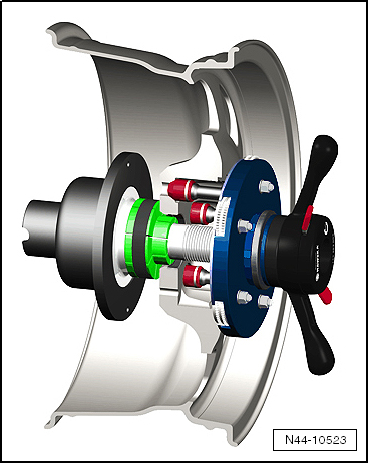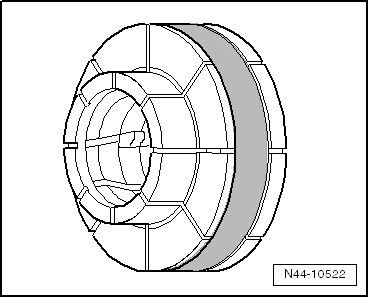Volkswagen Polo Service & Repair Manual: Wheel, Balancing on Stationary Balancing Machine
| Before beginning balancing, the following requirements must
be fulfilled. |
| The tire pressure must be OK. |
| The tire profile must not be worn on one side. The tire
profile must be at least 4 mm. |
| The tires must not have any damage such as cuts, holes,
foreign bodies, etc. |
| The suspension and steering, including the shock absorber,
must be in perfect condition. |
| Test drive performed. Refer to
→ Chapter „Vibration, Road Test, Performing Before Balancing“. |
 Note Note
| If equipped handle the glued-on wheel trim carefully.
Surface slightly scratched. |
| Replace the damaged rim wheel trim. |
| Use only the Model-Specific Clamping Plate VAS6652 -VAS6652-
and the Thrust Pin -VAS6652/1-. |
| Tension Wheel on Balancing Machine |
| Dirt and rust in the area of the contact surfaces and
centering of the wheel distort the result. |
| – |
Clean contact surfaces, centering seat and wheel disc using
the Pneumatic Brush Grinder Set -VAS6446- before tensioning
wheel on balancing machine! Refer to Workshop Equipment,
Catalog. |
 Note Note
| The wheel balancing machine must use the correct system for
centering and tensioning the tires when replacing them Reference
the information for the Wheel Balancing Machine Centering System
before beginning any work. Refer to Workshop Equipment, Catalog. |
|
|
|
| – |
Tension the wheel with the tire on the balancing machine. |
 Note Note
|
|

|
| To mount wheel on wheel balancer, use for example Wheel
Centering System Adapter -VAS5271-. |
| This way a 100% centering of the wheel and gentle mounting
is possible! |
| It is not possible to center it 100% on balancing machine
with conical tensioners. |
| With a deviation of 0.1 mm outside the center, there is an
imbalance of 10 grams on the wheel/tire. |
| Wheel/Tire Balancing Procedure |
| – |
Let the wheel/tire turn on the balancing machine. |
| – |
Check the run of the characteristic lines on the sidewall of
the tire in the area of the rim flange. |
| – |
Check the tire wear pattern while the wheel/tire is turning. |
 Note Note
| In the event of one-sided wear, flat spots from braking or
severe wear spots, smooth running cannot be achieved by
balancing. In this case, the tire must be replaced. |
| – |
Check the run-out on the wheel/tire. If the wheel with tire
runs untrue although there are no flat spots, a radial or
lateral run-out may be the cause. |
| – |
Check wheel with tire for radial- and lateral run-out. Refer
to
→ Chapter „Wheel, Balancing, Tire and Wheel Radial and Lateral
Run-Out, Checking“. |
| – |
If the radial and lateral run-out are within the specified
tolerance, balance the wheel and tire. |
 Note Note
| Do not use more than 60 grams of weight per wheel. |
| If more weight is necessary, a smoother running can achieved
by matched mounting of the tire. Matching a tire. Refer to
→ Chapter „Tires and Rims, Matching“. |
| The display in the balancing machine should show 0 grams. |
| Hunter RFT33VAG Road Force Touch™ Wheel Balancer -VAS6230B4-
can be inserted as an alternative to matching. Refer to
→ Chapter „Vibration, Vibration Control System“. |
| – |
Install the wheel on the vehicle. |
 Caution
Caution
| If brake pads are ceramics, wheel must not fall on
brake rotor, otherwise it will be destroyed. To
remove/install wheel, install long assembly pin instead
of wheel bolts in top position (12:00 position) and
short assembly pin in wheel bolt mounts for support. In
this way, the wheel can glide on the assembly aids when
removing/installing. |
|
| – |
Tighten the lowest wheel bolt by hand to approximately 30
Nm. |
| – |
Tighten the remaining wheel bolts diagonally to
approximately 30 Nm. This process centers the wheel on the wheel
hub. |
| – |
Lower the vehicle onto its wheels. |
| – |
Use a torque wrench to tighten the wheel bolts diagonally to
the specified tightening specification. |
| If a vibration is still detected during the road test, the
cause may be due to tolerance in the wheel centering. |
| The component tolerances of wheels and wheel hubs can be
additive in unfavorable cases. Vibration can result from this.
This can be eliminated using a finish balancer. Refer to
→ Chapter „Wheel, Balancing with Fine Balancing Machine (Finish
Balancer)“. |
|
|

|
Before beginning balancing, the following requirements must
be fulfilled.
The tire pressure must be OK.
The tire p ...
Other materials:
Changing bulbs in the front headlights (Xenon)
Fig. 181 Rear view of right-hand
Xenon headlight: ① cornering light and ② turn signal
First read and observe the introductory
information and safety warnings
The headlight needs to be removed in order to change a bulb.
The actions should only be carried ...
Lower section of the centre console
Fig. 8 Overview of the lower section of
the centre console
Key for :
Lever for:
Manual gearbox
Automatic gearbox
Stowage compartment in the front centre
console
12-volt socket
Drink holder
Handbrake
Stowage compartment in the centre
armrest
...
Preserving Wax (Spray Can)
Definition:
Preserving Wax -D 308 SP5 A1-
Edition 04/2009
Product Description
The Preserving Wax -D 308 SP5 A1- provides optimal corrosion
protection for areas in the body th ...
© 2016-2025 Copyright www.vwpolo.net

 Note
Note Note
Note Note
Note Note
Note Note
Note Wheel, Balancing
Wheel, Balancing Wheel, Balancing with Fine Balancing Machine (Finish Balancer)
Wheel, Balancing with Fine Balancing Machine (Finish Balancer)

 Caution
Caution